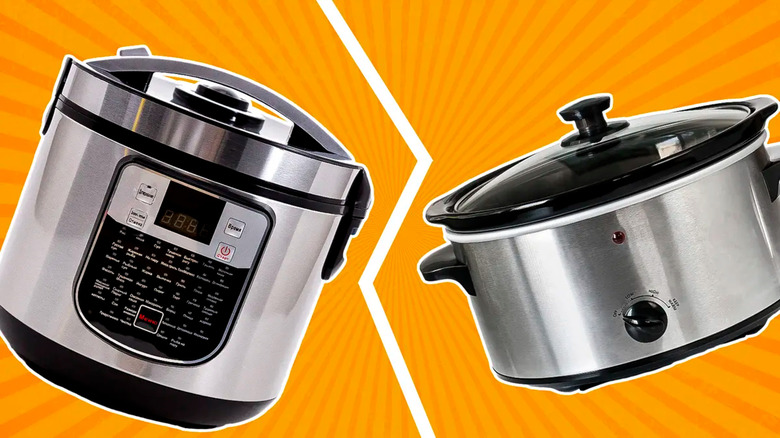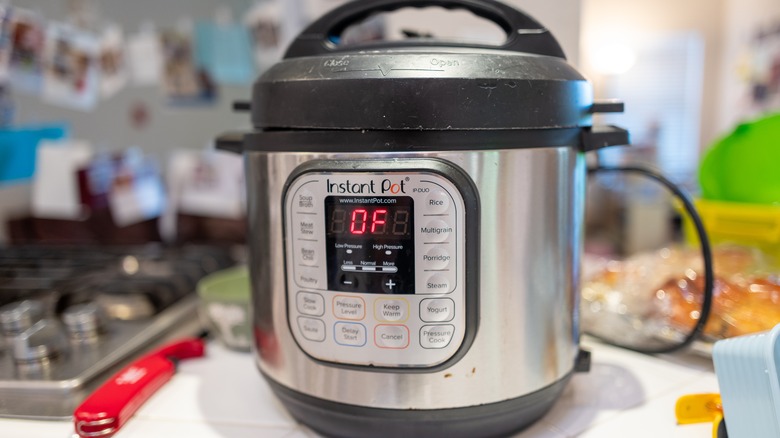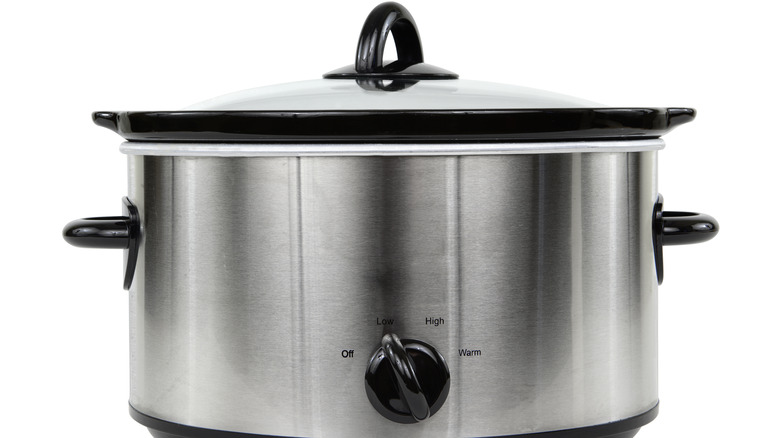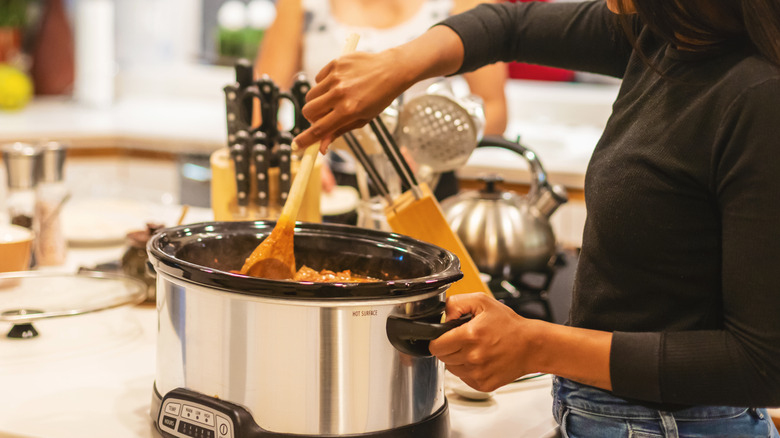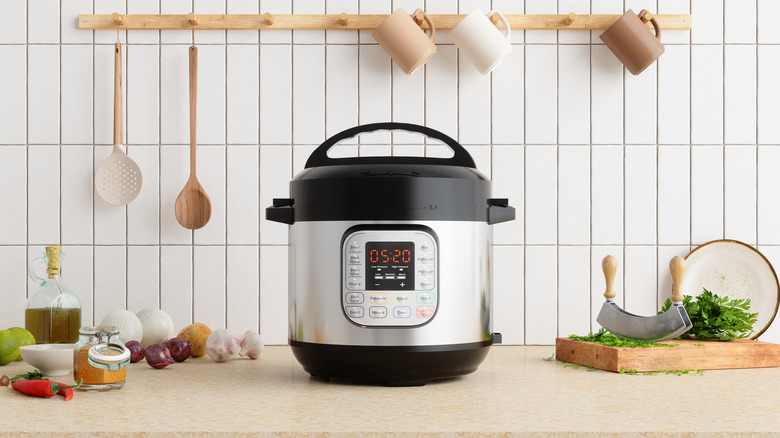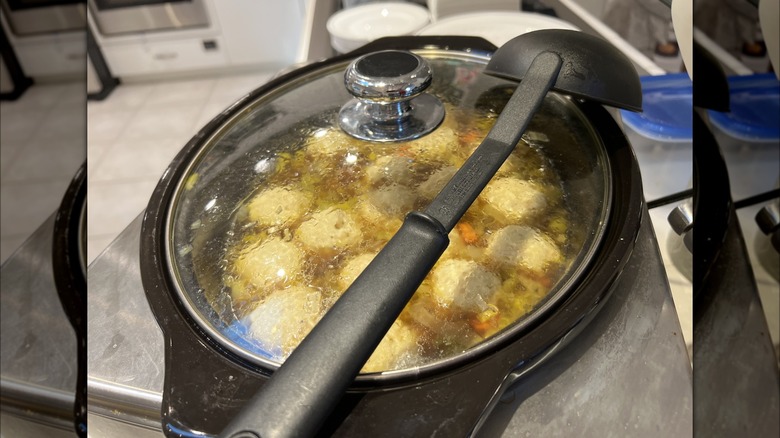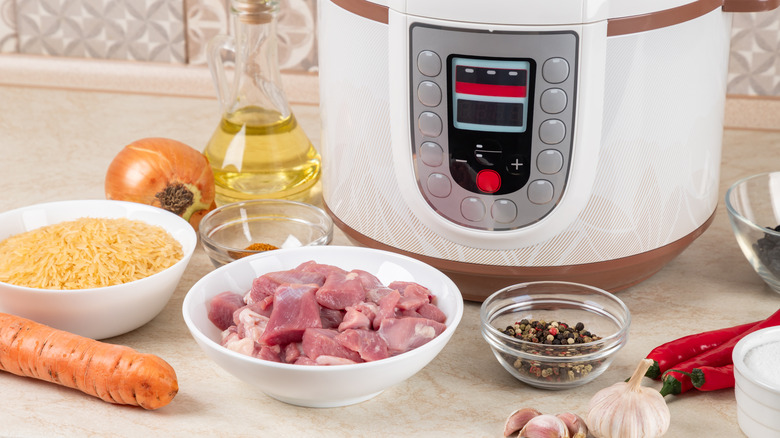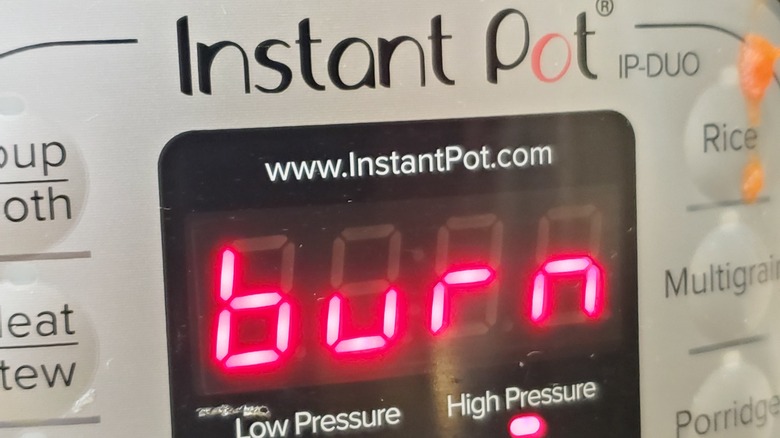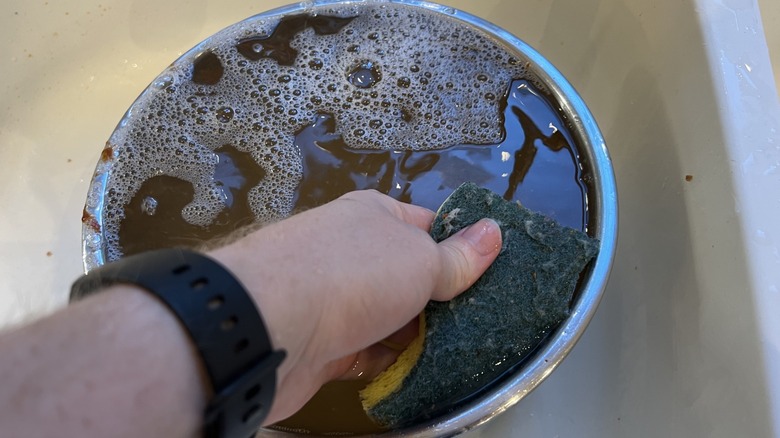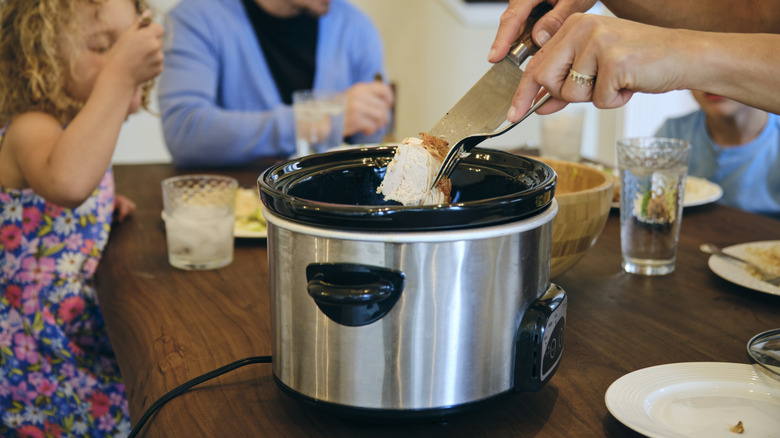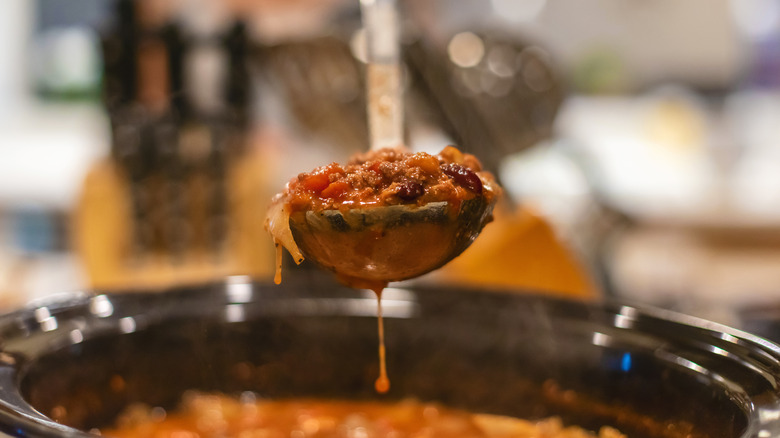Instant Pot Vs Slow Cooker: Which Reigns Supreme For Easy Meals?
When it comes to the ultimate simple-to-use counter top cooker, both the traditional slow cooker and the more recently-introduced Instant Pot are top contenders. Whether you're a busy chef throwing together multiple elements of a meal at once, a home cook preparing to feed a large crowd over the holidays, or a working parent prepping that night's dinner before rushing off to school drop-off and the office, the two appliances can prove extremely useful in keeping up with life's culinary demands.
But when it comes to which one to purchase when seeking your ultimate easy-meal cooker, it's worth considering which is the superior appliance. By weighing the various pros and cons inspired by product settings, online user reviews, and the writer's personal cooking experience, we've come up with a comprehensive summary to help you decide whether or not an Instant Pot or a slow cooker will reign supreme for producing stress-free meals in your kitchen.
What is an Instant Pot?
An Instant Pot is a multi-setting cooking appliance made famous for its celebrated electric pressure cooker setting. Unlike a traditional stove-pot pressure cooker, the Instant Pot can simply be plugged in to harness the pressure from steam, ultimately cooking foods at a super-speedy rate. The very first Instant Pot was released by the company Instant Brands Inc. in 2010, and though it's pressure-cooking ability was perhaps its most publicized feature, it offered a rice cooker, steamer, slow cooker, and yogurt making setting alongside its quick-cooking function. Some newer models have added air frying, broiling, bread making, and more to the product's list of available functions.
Since its introduction to the market, the multifaceted electric appliance has become a favorite kitchen staple for millions of consumers. Some swear by its rapid cooking time, which allows the busy working individual who forgot to prep a meal in the morning the ability to cook the full-scale entree they had planned on — even if it's from-frozen. Others appreciate its ability to perform a large number of tasks with its multiple settings, requiring the need for less items to be stored in your cabinets.
What is a slow cooker?
A slow cooker, also commonly referred to as a crock pot, is a single-function appliance that cooks food at low temperatures over a period of several hours. Released to the public in 1971, it was originally marketed to working women, appealing immensely as an appliance that could prepare dinner all day long safely on the counter top without needing doctoring. Naturally, the new appliance took the world by storm: 2 million were sold in the crock pot's first year on the market, and in a span of four years, the total sales grew to a whopping 93 million.
Since then, the slow cooker has made no moves in slowing down its popularity roll, maintaining its status as a common kitchen accessory in modern day homes. It has a single function — cooking low and slow — and food must be placed in its basket several hours prior to when the user plans on dining in order for the contents to be cooked through. Consumers applaud the slow cooker for its simplicity, ease of use, and lengthy cooking times, which subsequently produce super-tender and flavorful proteins.
Slow cookers have one cooking function, while Instant Pots have many
A slow cooker has a single purpose — to cook continuously over a long period of time. Most models have a simple dial or buttons that read low, medium, or high for the user to choose according to their needs. After the lid is locked and the knob is turned appropriately, the raw meat or veggie-filled casserole is left untouched, until the user checks it for doneness as the recipe dictates. The simplicity of the single dial, as well as the overall "start it and forget about it" approach appeals to many, as this straightforwardness makes for a stress-free cooking experience.
Conversely, Instant Pots are multi-functional cookers with a great many buttons and settings — so many, in fact, that some consumers tend to find them intimidating when starting out. Plenty of online tutorials exist for those who are confused about the multifaceted counter appliance, so a case could be made that the Instant Pot is much more complex from a technical standpoint. Still, for some consumers the appliance's various options add to feelings of ease surrounding its use. Since it can be relied upon to prepare such a wide scale of foods, home cooks don't have to scour their cabinets and clutter their counters with individual rice cookers, air fryers, or bread makers, for example.
Slow cookers require more time to cook, while Instant Pots are faster
There's no doubt about it: Instant Pots, as their title suggests, have the ability to get the job done faster. Given the electric pressure cooker feature that relies on steam build-up within the sealed basket, the appliance can cook a protein, such as chicken breast, in as little as eight minutes.
Slow cookers, on the other hand, use basic heat from the bottoms and sides of their basins as opposed to high pressure to cook, making them not so ideal in a time crunch. For the same chicken breast meal, you'd be looking at around three hours to completion, at the very least — a timeline that requires you to plan ahead. This means you'll have to make a point to save a few extra minutes in the morning to place the uncooked poultry on a bed of vegetables and set the appliance before walking out the door.
With an Instant Pot, however, there's no need to fret if the start of the day was particularly hectic and dinner wasn't considered before the evening. Given its rapid cooking time, you can start those juicy chicken breasts as soon as you walk in the door and still serve your family a delicious, nutritious meal. In this way, Instant Pots have the ability to save the day in a way that slow cookers can't.
Though Instant Pots have a 'slow cooker' setting, it isn't quite the same
Instant Pots may be celebrated for their quick cooking ability, but they actually have a slow cooker setting, as well. Once the ingredients are placed in the basket, the option for a multi-hour, lower-heat cook can be selected. Given this — along with all the other settings offered by the device, of course — you might be ready to rope the multifaceted appliance into the winner's circle. However, the slow cooker setting the Instant Pot brings to the table is not quite the same as the real thing, according to consumers.
"FYI, the Instant Pot is NOT a slow cooker," reads the title of a Reddit thread under which home cooks discuss disappointing flavors and confusing cook times stemming from their Instant Pot's slow cook function. In the discussion, one user refers to a 2018 study performed by America's Test Kitchen in which the Instant Pot was named inferior after its slow cooker setting was tested. The reason for this, per America's Test Kitchen's conclusions, is that less heat is able to permeate the contents within the Instant Pot. Thus, the appliance has a difficult time successfully preparing certain things, in particular, thicker cuts of meat. Far-reaching disappointment in the Instant Pot's slow cooker function among home cooks seems to confirm this, leading us to believe that traditional slow cookers are king when it comes to their namesake function.
While slow cookers might be best for meat, Instant Pots have their own areas of expertise
Since Instant Pots are considered by many to be subpar to classic slow cookers for a low-and-slow cooking process, one could make the case that certain fatty meats that require longer cook times to draw out flavor — such as pulled pork, brisket, or ribs — might be better suited simmering for hours in the deep basin of a classic slow cooker. Still, there are plenty of entrees, sides, and snacks that can be perfectly prepared in an Instant Pot that you might not want to make in a slow cooker.
Crafting homemade yogurt with the yogurt maker setting, softening beans or steaming hard boiled eggs with the pressure cooker function, baking sourdough with the built-in bread maker, or making wild rice via the rice feature, are all successful recipes for the Instant Pot, as consumers note on various online platforms. Other home cooks claim their stews or soups — which in true Instant Pot fashion can be finished in an hour — end up particularly flavorful. You'll have to take a look at your personal recipe bank and consider what you prepare most often when deciding which one of these appliances would align most naturally in your home.
They are both safe to leave unattended, but Instant Pots will actually stop if your food is burning
From the beginning, slow cookers and Instant Pots have been marketed to the busy consumer who is presumably away from the kitchen for much of the preparatory process. If used correctly, both appliances are considered safe to leave unattended on the counter while you juggle work, school, errands, or frequent ins-and-outs. But when it comes to being able to set it and forget it, the Instant Pot might just have a slight leg up. Unlike the slow cooker, the multi-functional appliance comes with an automatic burn sensor.
The Instant Pot's safety feature instantly shuts off heat to the appliance if it detects any sort of burning within. In addition to saving your meal, this feature could go a long way toward saving your house in the event of an emergency. Though some newer models of the original slow cooker come with elevated safety features, such as programmable timers or a maximum number of running hours before shutting off, the burn sensor on the Instant Pot might just take the cake when it comes to keeping a dinner disaster at bay.
Instant Pots usually require significantly less cleanup
Let's face it: Slow cookers can be a nightmare to clean. Lifting a massive ceramic basin onto the counter to soak for several hours after caked-on meat, potato skins, or burnt onion bits have adhered to the sides isn't the easiest of endeavors, but it's sometimes a necessary part of the process when it comes to using the appliance.
As for cleaning up after an Instant Pot meal, things might go a little smoother. This is because the product has a stainless steel inner pot, which customers highlight as being extremely easy to scrub or wipe clean. "The inner pot I fill with hot soapy water and immediately hand wash it. I don't see a need to soak it; it cleans easily. [...] The whole process probably takes me a maximum of 5 minutes. It is very easy to clean," confirmed a user on Reddit under r/instantpot.
While less material might be caked onto the Instant Pot's inner shell, there are more individual parts that might need cleaning depending on what you've prepared. Smaller, removable pieces like the sealing ring or the steam rack, for example, will likely also need a cleanse post-use, so this is worth noting when weighing the overall cleaning required by the two products.
Your individual needs and preferences will determine which one is best for you
When considering whether or not an Instant Pot or slow cooker reigns supreme for easy meals, the answer is simple: It depends. The truth is, the answer will vary per person, depending on their preferences, needs, cooking habits, intentions, and recipes. If fewer buttons and settings, ease of set-up, a slower flavor development for meats, and a longer (but more straightforward) clean appeals to you, a slow cooker may provide the easiest option.
However, if you personally find the variety that comes with multiple settings in a single device attractive, are short on time, find getting your meal in before you leave for work a challenge, or could do with an advanced burn-evading setting, then you might find that an Instant Pot would make your cooking situation simpler. The good news? There's no right or wrong. Both of these appliances are tried and true beloved members of millions of kitchens worldwide, and only you can decide which one gets the first place cooking ribbon.
Methodology
To create our comparison weighing the benefits of slow cookers and Instant Pots, several factors were taken into account, including the writer's knowledge and cooking experiences, recipes from various blogs, consumer discussions on platforms like Reddit and Amazon, as well as current information regarding updated models, speeds, functions, timers, and safety features from product websites. It is important to note, however, that not every model and brand is the same, and what works for one person may not work for another.
